 Daily
Global Market Outlook
Daily
Global Market Outlook
$40 Oil
21 January 2003
a currency & gold market analysis
by Ed Bugos
| Print Copy |
Saddam had better disarm. Why doesn't he? Why is he being so uncooperative? Bush's team is putting together a white paper on Iraq's noncooperation, specifically that it refuses to disarm and is running out of time. Tuesday morning Bush said it was "clear" to him now that Saddam is just not going to disarm. Forgive me for trying to maintain some clarity myself, but if Bush and friends know where the nukes are, they should get the coordinates to Hans Blix for God sakes! Then we'll all believe the stupid white paper.
The President of the United States says Iraq is armed, but nobody can prove it. I don't know what he plans to do with the white paper, but we have a few suggestions. Don't get any on your shoe. Creepers, I hope Bush doesn't ever think Canada has nukes. Why won't that Cretin disarm? Nah, doesn't quite chime does it?
Maybe, just maybe, Saddam doesn't have any nukes. For all we know, Osama didn't do 9-11. Where's the proof? Is it the same kind of proof Bush's got about Saddam's nukes? And we want to go to war over this vague nonsense? The US should just find the nukes it says it knows without a doubt that Saddam has. Put up or shut up.
Oil is going to be a big winner again this week if the report on last week's inventories holds any bullish surprises. Already Tuesday morning the bulls pinned Brent up against a two year high in Europe. Though NYMEX Crude already broke to new two year highs on Friday. Initial impetus came from the report that a US defense department employee was gunned down in Kuwait overnight, being the most recent in a string of such attacks on (the build up of) US soldiers in the region.
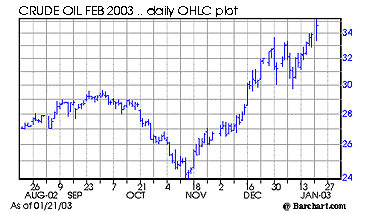 However,
in Venezuela, Chavez claims to be on top of the situation, and has managed
to encourage sympathetic remarks from Fidel Castro in Cuba. Both were
quoted over the wires as saying that Chavez' striking opponents were largely
defeated. Indeed, later in the day confusion arose because in western
Venezuela reports surfaced that tanker pilots there ended the strike.
Reuters said that a spokeswoman for the striking workers said they still
have 90% of oil workers on strike.
However,
in Venezuela, Chavez claims to be on top of the situation, and has managed
to encourage sympathetic remarks from Fidel Castro in Cuba. Both were
quoted over the wires as saying that Chavez' striking opponents were largely
defeated. Indeed, later in the day confusion arose because in western
Venezuela reports surfaced that tanker pilots there ended the strike.
Reuters said that a spokeswoman for the striking workers said they still
have 90% of oil workers on strike.
It's not clear to me what could happen in Venezuela, but Chavez said that he expects oil production to recover to 2 million barrels per day by the end of January, which would still only be two thirds normal. Estimates of output are at about 600,000 barrels per day right now, but who knows how much is being exported. And I don't want to speculate on when exactly Saudi oil will reach US shores, but I think we have a few weeks yet. In the meanwhile, the market is still tight, and news from the energy department of a surprise shortfall in supplies could be tinder, particularly since oil prices appear to have just completed the breakout of a large two year bottom and overall inventories are hovering near a record low. I know, just in time delivery means we don't need to keep any on stock. Right.
The usual suspects are calling for a collapse in oil prices, you know, investors that turn bearish on something as soon as it goes up more than usual. But consider some things. Iraq and Venezuela may be in the headlines today; someone else will be tomorrow. The fundamental primary drive for higher oil prices are the following factors:
- maturing global production rates; declining rates in North America
- low reserve (oil well) replacement rates, high depletion rates, and possibly, an absence of viable alternative energy sources to replace fuel, as had been expected
- hedonic consumption policies encouraged by long periods of cheap money and oil have increased the US economy's reliance on oil imports at a time when the currency is weak
- an inflationary fiat money regime that fuels excess where ever the inflation chooses to go
And as one oil market source points out, demand has been outpacing expectations despite the so-called deflationary economic and geopolitical shocks over the past few years. When demand grows faster than expected it might mean that oil prices are below market price, or in other words, still too cheap. We've already seen what the Fed's inflation policies have done to stock and real estate markets. In each case valuations always went further than anyone would have imagined. After slashing rates from 6% to almost 1%, if anyone still doubts their inflation agenda, naturally they'd be bearish on oil.
Moreover, dollar devaluation is particularly intense with respect to oil because anti-US sentiment is on the rise in many oil producing regions of the world, it just so happens.
If you're looking at a chart and decide to get bearish because oil prices are up 70% on the year and because they're up near all time highs, I hope your outlook is short term, because I think new records are about to be set as the aforementioned fundamentals increasingly come to a head.
Barring a short term bearish blow from good news over the Venezuelan strike or US-Iraq situation, or from the EIA this week, we anticipate $40 oil in the first six months of the year. That's a conservative estimate. For, the technical objective of a break out from the two year bottom in oil prices is a move to the mid $50's. We'll make it a medium term to long term goal with the caveat that if war breaks out, anything could happen, but it is likely to happen on the upside first.
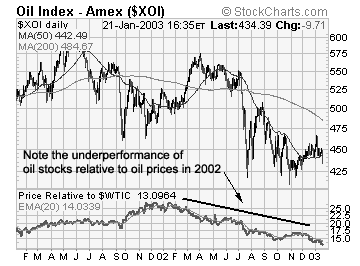 Indeed,
both gold and oil stocks haven't factored our outlook for gold and oil
prices this year, let alone our long term outlook. However, we've also
seen that gold shares have proven more resilient to a broad market downturn
than oil shares, and that technically speaking, there are few sectors
whose charts are developing as bullishly as that of the gold stocks.
Indeed,
both gold and oil stocks haven't factored our outlook for gold and oil
prices this year, let alone our long term outlook. However, we've also
seen that gold shares have proven more resilient to a broad market downturn
than oil shares, and that technically speaking, there are few sectors
whose charts are developing as bullishly as that of the gold stocks.
Earnings news is going to impact the market hard this week. If anyone's been holding out for good news, they're not getting much of it so far. They will. There will probably be good and bad news, and I have no idea in what order. The bank stocks have been late in releasing their results, but maybe it's nothing. Well, since Thursday when we were supposed to hear from JP Morgan, first call estimates have dropped to a loss of 9 cents from forecasts that averaged a loss of 2 cents, which themselves were dropped from a gain of some 30 cents a month or so back. It probably doesn't matter though. They'll just increase their dividend the moment Bush's tax plan is passed.

Citigroup reported 47 cents per share, which was a couple of cents better than the sharply downward revised number, but also the first year over year decline in earnings since the Jan-Mar 2001 quarter.
Stock prices have been mostly developing sluggishly on the charts since peaking in November just short of signaling a reversal of the intermediate bear market sequence in the major stock market averages. In the first week of the New Year, the bulls put off a failure of the recent bull run by rallying off of key short term support for all the major averages (Dow, S&P, Nasdaq, etc). But they haven't been successful in extending the bullish sequence. Now that sequence is again seeing a test.
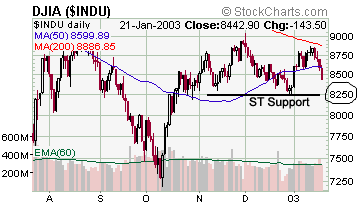 The
support points haven't changed much. For the Dow it's about 8250, for
the Nasdaq composite it's about 1320, and for the S&P 500 support
is at about 870. What that means is that if the averages fall through
them, the bulls will have relinquished control over the short term trend
to the bears, which still control the main bear market sequence. A test
of October's lows would probably follow, and if our outlook is right,
should fail.
The
support points haven't changed much. For the Dow it's about 8250, for
the Nasdaq composite it's about 1320, and for the S&P 500 support
is at about 870. What that means is that if the averages fall through
them, the bulls will have relinquished control over the short term trend
to the bears, which still control the main bear market sequence. A test
of October's lows would probably follow, and if our outlook is right,
should fail.
As far as Dow components go, we expect the most interesting bearish news from the banks and perhaps McDonalds, which also has seen a meaningful drop in its fourth quarter outlook and is expected to report by Friday.
 However,
if the bulls can weather Morgan's news they might be able to get something
out of the oil rally, because Exxon's estimates have ticked higher in
recent weeks and it reports Thursday along with Boeing. Both Boeing and
Exxon's shares have been trading like soggy bananas.
However,
if the bulls can weather Morgan's news they might be able to get something
out of the oil rally, because Exxon's estimates have ticked higher in
recent weeks and it reports Thursday along with Boeing. Both Boeing and
Exxon's shares have been trading like soggy bananas.
Exxon is expected to report 50 cents for the fourth quarter, which would make it the best quarter the company's had since the first half of 2001, when oil prices were last at the same level as they were during the last six months.
The average estimate for earnings according to First Call is $1.92 in 2003. If the company made better than $2 per share during both 2000 and 2001 while oil prices averaged the mid $20 range, maybe they'll beat expectations in 2003. As it stands now, I don't like the way the stock is trading. And I don't know if the market will like Exxon's earnings. But if it does, it's a bullish sign. Moreover, in a bull market for gold and oil, the producers have increasing surplus cash reserves that they tend to pay out in dividends.

Interestingly, Bush's taxplan would be quite bullish for companies that could afford to pay out a rising stream of dividends, such as the commodity producers in a commodity bull market. That's how to make inflation work for America!
Although, they're going to have to put a gold stock in the Dow to prevent Dow 6000 first. I don't think the gold and oil stocks sway enough weight in the averages yet to hold them up while the rest of the market crumbles. And I'm not confident in our prognosis for oil stocks in light of the chart behavior of key components. But I'd be willing to argue that Exxon is fairly valued at today's oil prices, and undervalued at $40. What it tells me is the obvious, that the market doesn't yet believe in $40 oil.
Do you?
Housing starts, a leading indicator for house prices, continued to surprise bears in that sector on Tuesday when they reportedly rose to their highest levels since 1986. They rose 5% in December over November's upwardly revised levels. Permits leapt 8%. Starts of single family homes were at their highest since 1978. The lowest mortgage rates in over 40 years are routinely credited for the strength in this sector of the economy. Of course that's true. But also, the dollar's weakness has something to do with it. House prices have grown at a faster clip since the peak in the stock averages almost three years ago. This isn't a coincidence. There is a strong inverse correlation between the rate of return in stocks and the rate of return on real estate assets. It just so happens that the dollar's value is central to understanding it.
But the news on housing starts did nothing for homebuilders today. The S&P home building index was off a fraction. Bulls are still in charge of the long term trends there, but unlike the case for gold stocks, they have let the bears keep them from reasserting the intermediate sequence. Harley Davidson reported record profits, but the stock fell 8%. Hey, didn't CNBC just recently do a spot on how the company is opening its market to female bike riders? Still up to their old stunts I see. Why do the deals that CNBC promote always look like they're undergoing some type of distribution?
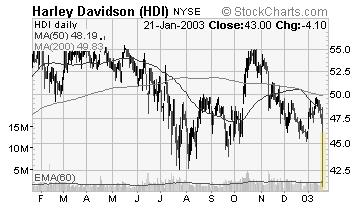 Besides,
the record profit was actually not that great considering a 24 times earnings
multiple. The company reported a year over year rise in sales and profits
but a decline relative to the prior quarter.
Besides,
the record profit was actually not that great considering a 24 times earnings
multiple. The company reported a year over year rise in sales and profits
but a decline relative to the prior quarter.
The point is that even on good news these stocks continue to trade badly. Doesn't sound like a cheap market. Despite a strengthening base metal complex, moreover, Alcoa led the Dow lower Tuesday. It was down more than 4%, and if we mapped the Alcoa chart over the Dow, it might be telegraphing a break through support for the Dow as well.
Gold prices didn't react to the killings in Kuwait like Oil did, but as the day wore on and the broader stock averages sank further, along with the dollar, gold bulls woke up. Over the weekend, gold prices pulled back from Friday's $359 high to just above $353 before closing at $357.50 on the COMEX Tuesday. In ACCESS after market trade, the price of gold has moved back up toward $358.
Gold shares were mostly up, but drifted a little by the close in New York. The sector was the second best performing S&P sector of the day. Internet Retail was first.
| The Bugos Gold Index (BGI) | Jan 21 |
| Agnico Eagle Mines | 2.72% |
| Harmony Gold Mining | 1.95% |
| Goldcorp | 1.83% |
| Newmont Mining Corp | 0.87% |
| Anglogold Ltd | -0.20% |
| CBOE Gold Index | 0.67% |
| PHLX Gold and Silver Index | 0.46% |
| AMEX Gold BUGS Index | -0.15% |
| S&P 500 Gold | 0.87% |
All together, there were only five S&P sectors in the plus column. The Dow ended down 142 points, and only 200 points away from support. Although the gold shares are trading better than most sectors of the market are today, even there the good news hasn't had the impact it perhaps should have had. Still, it's easier to imagine the news getting better there than for corporate profits generally. They aren't cheap, but relative to our outlook for gold, they are undervalued.
Many producers are just coming out of a multi-year slump, and have recently capitalized on their first opportunity in years to raise money. Their fundamentals, which deteriorated during the deep bear market, are only now being repaired, so they don't yet paint a bullish picture themselves. The resulting expensive profile of the stocks is a typical early cycle development, but mainstreet has been applying it to the rest of the market as if there were always a new bull market just waiting around the corner. The difference is that while there are few signs of improving fundamentals amongst the overall debris, the gold sector is one of the few places it is occurring.
We don't expect the earnings picture to add to the momentum or outlook for gold shares until the end of 2003. However, we do expect the market to discount it ahead of the fact. It has already to an extent, but the market isn't generally factoring $425 gold yet. It's not as bullish as we are!
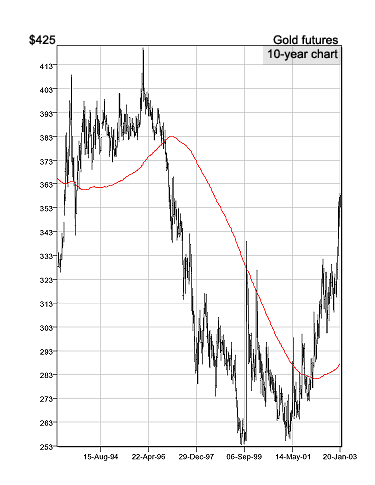 The
big question of course boils down to whether our outlook is aggressive
or conservative. Relatively speaking, $425 is neither. If it's anywhere
near correct, the upside in gold stocks is very attractive.
The
big question of course boils down to whether our outlook is aggressive
or conservative. Relatively speaking, $425 is neither. If it's anywhere
near correct, the upside in gold stocks is very attractive.
Put aside all the other factors you've been considering for a moment, and consider that the dilutive effect of certain financings in the second half of 2002 have been a drag on the equities, but concurrently, company treasuries have built up. If we're correct about our outlook, and the market refuses to bid up these stocks, we're expecting a wave of consolidation and takeovers to sweep the sector. This argument is particularly strong if one considers the lack of viable resources that overly hedged producers like Barrick could transform into reserves in order to settle their hedges in a rising gold price environment.
Hedgers need reserves, and several mid-tier companies not only have reserves, but a whole lot of cash. The landscape is ripe for someone to gobble up the cheap assets in the bunch.
At any rate, unlike the rest of the dear stock market, gold stocks are at least still acting bullish on good news, or bullish developments, even if they're not taking a leadership role. This indicates little, and could change any day. It only indicates to me that gold shares are hesitant in factoring higher gold prices at the moment, and perhaps that they've attracted a few investors whose hopes for a coincident Dow/Gold sector stock rally are fading. In the latter case, a falling Dow might scare them off. And if it doesn't, rising interest rates might. But they'd be selling to investors betting on a combined Dow-Bond-Dollar selloff. And we'd bet on the buyers.
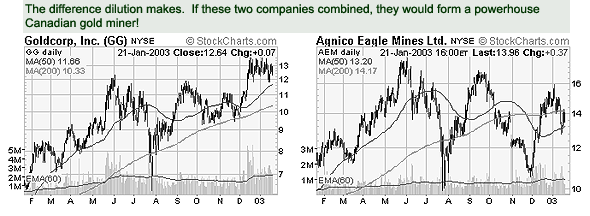
So far, we've been right to own gold shares despite the criticism that gold shares were likely to fall with the Dow. The reason they haven't, as we've stated many times in the past, is that this is the first bear market on Wall Street where the dollar turned down AFTER the fact.
In prior cycles, gold shares would rally with the final leg in the averages because the dollar had already turned down. So that when the market peaked, so did the gold stocks. This cycle is immensely different in that regard.
We continue to believe that gold equities will be the best performing sector during the first half of the New Year on the notion that investors will up their gold price outlooks as the Dow and dollar continue to fall. Unlike other commodity related stock sectors whose charts have stayed or turned bearish on the prospect of stronger underlying commodity prices, at least the charts of most gold shares don't reject our hypothesis. Confirming it means getting there.
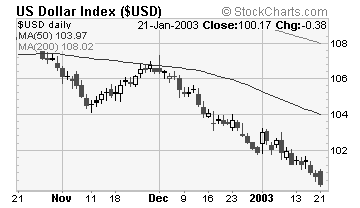 A
new source of demand for gold potentially emanates from Mexico as the
peso fell under increasing pressure Tuesday. The currency was off 2% against
the greenback and has accelerated to new four year lows on a chart. But
it didn't help the dollar index much, which fell another half percent
today. The weakness in the dollar is relentless, but I still sense that
the market is waiting out a test for dollar/yen and the dollar index a
touch lower. It's gotta' be soon. At the rate of the dollar's current
descent, it could be this week. The near term action in gold and gold
shares I think is thus going to be key in guessing the outcome.
A
new source of demand for gold potentially emanates from Mexico as the
peso fell under increasing pressure Tuesday. The currency was off 2% against
the greenback and has accelerated to new four year lows on a chart. But
it didn't help the dollar index much, which fell another half percent
today. The weakness in the dollar is relentless, but I still sense that
the market is waiting out a test for dollar/yen and the dollar index a
touch lower. It's gotta' be soon. At the rate of the dollar's current
descent, it could be this week. The near term action in gold and gold
shares I think is thus going to be key in guessing the outcome.